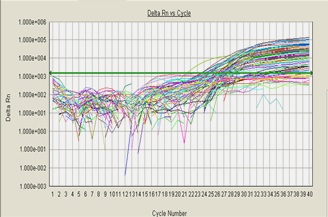Comparative analysis of biochemical parameters and gene expressions of novel markers in type II Diabetes mellitus
Abstract
Background: Diabetic nephropathy (DN) is the most common cause of end stage renal disease (ESRD). Early detection of the disease and treatment of this chronic complication which would reduce the medical and economic burden. Early detection of kidney injury by evaluating gene expressions of Il-6, Il-10, LDLr, and CD36 in T2DM with pre-ESRD microalbuminuria minimizes the risk of DN.
Methods: Present research work conducted at the Department of Biochemistry, School of Medicine, Navi Mumbai. This study includes 241 subjects (118 male, 123 women, and age ranges 30-70 years) were included after screening for T2DM by measurement of blood glucose in fasting, post-prandial, glycosylated haemoglobin. Microalbumin in urine and e-GFR is measured to eliminate patients of ESRD. Subjects were recruited after written consent and enrolled as per inclusion/exclusion criteria. Categorization of subjects in three study groups; group I (30-45 years), group II (46-70 years) were done on the basis of T2DM duration 3-6 years, glycosylated haemoglobin level (HbA1c) ≥ 7.0% with fasting blood glucose ≥126 mg/dl) and microalbuminuria (30-300 mg/dl) in study group, equal numbers of healthy volunteers enrolled in control group. Blood samples were processed for other renal parameters and RT-PCR to check expressions of novel genes
Results: In study groups all renal, lipids parameters are within normal range except albumin/creatinine ratio (p <0.012), e-GFR (p <0.00) and cholesterol (p <.00). Descriptive analysis showed high significance (p <.00) of delta CT gene expressions, parameters in pre-ESRD microalbuminuria subjects.
Conclusion: Screening biochemical renal parameters are not enough to prevent DN even in microalbuminuria. Early detection of gene expressions of novel biomarkers predicts risk of kidney injury. Early intervention may prevent morbidity and mortality of kidney due to diabetic nephropathy.
Downloads
References
Bethesda MD. United States Renal Data System. USRDS2007 Annual Data Report: National Institute of Diabetes and Digestive and Kidney Diseases, National Institutes of Health, U.S. Department of Health and Human Services; 2007.
Qi L, van Dam RM, Meigs JB, Manson JE, Hunter D, Hu FB. Genetic variation in IL6 gene and type 2 diabetes: tagging-SNP haplotype analysis in large-scale case–control study and meta-analysis. Human Molecul Genet. 2006; 15 (11):1914-20.doi: https://doi.org/10.1093/hmg/ddl113
Fishman D, Faulds G, Jeffery R, Mohamed-Ali V, Yudkin JS, Humphries S,. The effect of novel polymorphisms in the interleukin-6 (IL-6) gene on IL-6 transcription and plasma IL-6 levels, and an association with systemic-onset juvenile chronic arthritis.J Clin Invest. 1998;102(7):1369-76.doi: https://doi.org/10.1172/JCI2629
Vozarova B, Fernández-Real JM, Knowler WC, Gallart L, Hanson RL, Gruber JD, et al. The interleukin-6 (-174) G/C promoter polymorphism is associated with type-2 diabetes mellitus in Native Americans and Caucasians. Hum Genet. 2003; 112(4): 409-13. Epub 2003 Feb 14.doi: https://doi.org/10.1007/s00439-003-0912-x
Kubaszek A, Pihlajamäki J, Komarovski V, Lindi V, Lindström J, Eriksson J, et al. Promoter polymorphisms of the TNF-alpha (G-308A) and IL-6 (C-174G) genes predict the conversion from impaired glucose tolerance to type 2 diabetes: the Finnish Diabetes Prevention Study. Diabetes. 2003;52(7):1872-6.doi: https://doi.org/10.2337/diabetes.52.7.1872
Mysliwska J, Zorena K, Semetkowska-Jurkiewicz E, Rachon D, Suchanek H, Mysliwski A. High levels of circulating interleukin-10 in diabetic nephropathy patients. Eur Cytokine Netw. 2005;16(2):117-22.
Sinuai I Averbukh Z., Gitelman I., Rapoport MJ., Sandbank J., AlbeckM.,et al. Mesangial cells initiate compensatory renal tubular hypertrophy via IL-10-induced TGF-beta secretion: effect of the immuno-modulator AS101 on this process, Am. J. Physiol. Renal Physiol 2006; 291(2): F384-94.doi: 10.1161/HYPER-TENSIONAHA.118.11239
Susztak K, Ciccone E, McCue P, Sharma K, Böttinger EP. Multiple metabolic hits converge on CD36 as novel mediator of tubular epithelial apoptosis in diabetic nephropathy. PLoS medicine. 2005; 2 (2): e45. doi: https://doi.org/10.1371/journal.pmed.0020045
Zhang Y, Ma KL, Ruan XZ, Liu BC. Dysregulation of the low-density lipoprotein receptor pathway is involved in lipid disorder-mediated organ injury. Int J Biol Sci. 2016;12(5):569.doi: http://www.ijbs.com/v12p0569.htm
Suvarna Sanas, Yadav KS.Gene Expressions and Polymorphisms of Novel Biomarkers in Diabetic Nephropathy. IJBCRR. 2018; 21(1):1-9.doi: https://doi.org/10.9734/IJBCRR/2018/39263
Abd-Allha E, Hassan BB, Abduo M, Omar SA, Sliem H. Small dense low-density lipoprotein as a potential risk factor of nephropathy in type 2 diabetes mellitus. Indian J EndocrinolMetab. 2014;18(1):94-8. doi: http://www.ijem.in/text.asp?2014/18/1/94/126585.
Hirano T, Naito H, Kurokawa M, Ebara T, Nagano S, Adachi M,et al. High prevalence of small LDL particles in non-insulin-dependent diabetic patients with nephropathy.Athero. 1996;123(1-2):57-72. DOI: https://doi.org/10.1016/0021-9150(95)05772-2
Sekizuka K, Tomino Y, Sei C, Kurusu A, Tashiro K, Yamaguchi Y, et al. Detection of serum IL-6 in patients with diabetic nephropathy. Nephron. 1994;68 (2): 284-5. DOI: https://doi.org/10.1159/000188281
Khot VV, Yadav KS. LDLr Gene Expressions: A Novel Biomarker in Risk Prediction of Renal Injury. IJHSR. 2017;7(3):37-41.
Behzadi P, Torabi F, Amini M, Aminorroaya A. Comparison of ox-LDL levels in diabetic patients with normo-, micro-, and macroalbuminuria with their first degree relatives and the healthy control group. Int J Endocrinol. 2012;2012.doi: http://dx.doi.org/10.1155/2012/167154.
Nakhjavani M, Esteghamati A, Khalilzadeh O, Asgarani F, Mansournia N, Abbasi M. Association of macroalbuminuria with oxidized LDL and TGF-beta in type 2 diabetic patients: a case-control study. Int Urol Nephrol. 2010;42(2):487-92. doi: https://doi.org/10.1007/s11255-009-9643-9.
Khot VV, Yadav KS, Patil SB Expressions of CD36: Predictor marker of the early Kidney Injury in Type 2 Diabetic Mellitus. IOSR-JDMS. 2017; 16 (3): 113-117



 OAI - Open Archives Initiative
OAI - Open Archives Initiative


